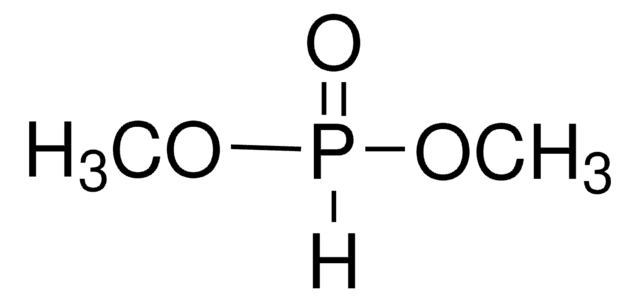415642
Ethyl phenylphosphinate
94%
Synonyme(s) :
Ethoxyphenylphosphine oxide, O-Ethyl phenylphosphinate, Phenylphosphinic acid ethyl ester
About This Item
Produits recommandés
Niveau de qualité
Pureté
94%
Forme
liquid
Indice de réfraction
n20/D 1.526 (lit.)
Point d'ébullition
94-95 °C/1 mmHg (lit.)
Densité
1.129 g/mL at 25 °C (lit.)
Chaîne SMILES
CCO[PH](=O)c1ccccc1
InChI
1S/C8H11O2P/c1-2-10-11(9)8-6-4-3-5-7-8/h3-7,11H,2H2,1H3
Clé InChI
UNUJZVUJPIOMGH-UHFFFAOYSA-N
Description générale
Application
- imidazol-2-yl-methyl(N-butylamino)phosphonate diethyl ester
- imidazol-2-yl-methyl(N-benzylamino)phosphonate diethyl ester
- imidazol-2-yl-methyl(N-butylamino)phenylphosphinate ethyl ester
- imidazol-2-yl-methyl(N-benzylamino)phenylphosphinate ethyl ester
Code de la classe de stockage
10 - Combustible liquids
Classe de danger pour l'eau (WGK)
WGK 3
Point d'éclair (°F)
235.4 °F - closed cup
Point d'éclair (°C)
113 °C - closed cup
Équipement de protection individuelle
Eyeshields, Gloves, multi-purpose combination respirator cartridge (US)
Faites votre choix parmi les versions les plus récentes :
Déjà en possession de ce produit ?
Retrouvez la documentation relative aux produits que vous avez récemment achetés dans la Bibliothèque de documents.
Les clients ont également consulté
Notre équipe de scientifiques dispose d'une expérience dans tous les secteurs de la recherche, notamment en sciences de la vie, science des matériaux, synthèse chimique, chromatographie, analyse et dans de nombreux autres domaines..
Contacter notre Service technique![[Pd(OAc)2]3 reagent grade, 98%](/deepweb/assets/sigmaaldrich/product/structures/508/249/99a0ef2c-b77c-4d73-8ed9-0cca05b6b41f/640/99a0ef2c-b77c-4d73-8ed9-0cca05b6b41f.png)
